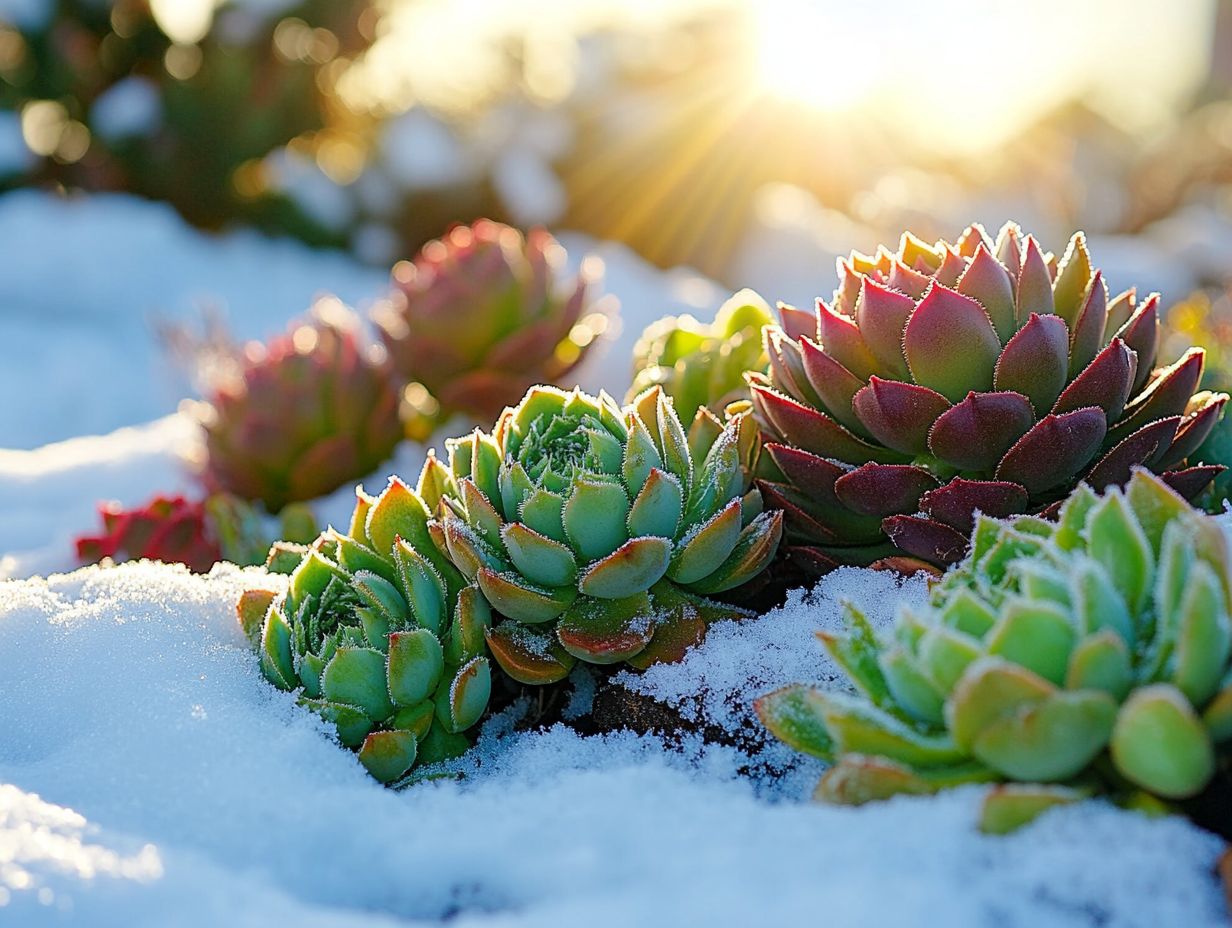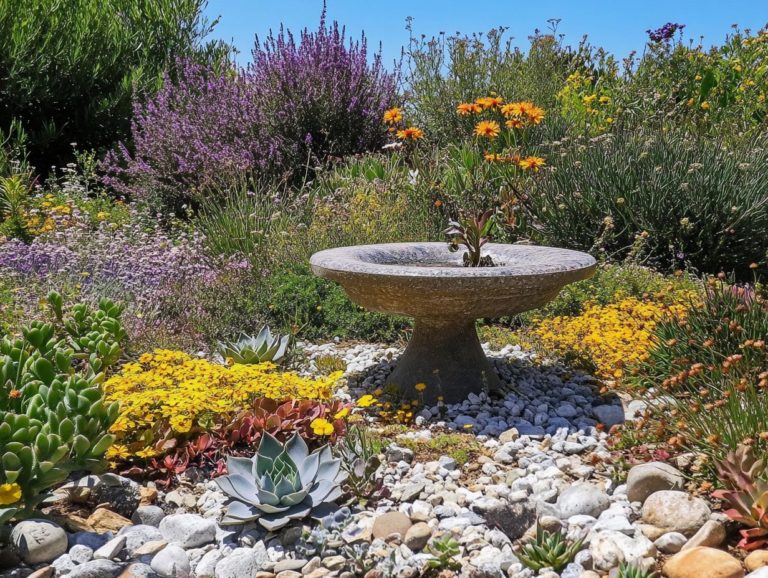Can Drought-Resistant Plants Survive Winter?
Drought-resistant plants, often referred to as drought-tolerant species, are renowned for their impressive ability to flourish in arid environments. You might wonder how they cope when winter arrives.
This article delves into the captivating realm of these resilient plants. We will highlight their unique adaptations that enable them to withstand both frigid temperatures and dry spells, making them ideal for landscaping in various climate zones.
You ll uncover the challenges they encounter during winter, the clever strategies they employ to survive, and essential tips for selecting and caring for these hardy additions to your garden.
Learn how to maintain a vibrant landscape filled with beautiful flowers, even amid the most unforgiving conditions.
Contents
- Key Takeaways:
- Understanding Drought-Resistant Plants
- Surviving Winter: Challenges for Drought-Resistant Plants
- How Drought-Resistant Plants Adapt to Winter
- Selecting the Best Drought-Resistant Plants for Winter
- Tips for Maintaining Drought-Resistant Plants in Winter
- Frequently Asked Questions
- Can drought-resistant plants survive winter?
- What makes a plant drought-resistant?
- Do all drought-resistant plants have the same level of winter hardiness?
- How can I care for drought-resistant plants during winter?
- Are there any tips for protecting drought-resistant plants in winter?
- Can drought-resistant plants survive winter in all climates?
Key Takeaways:

- Drought-resistant plants are specifically adapted to survive in dry conditions, making them a great option for creating stunning landscapes.
- Winter poses big challenges for drought-resistant plants due to the combination of cold temperatures and lack of moisture.
- You can help these plants survive winter by choosing the right varieties for your climate and following best practices for winter care.
Understanding Drought-Resistant Plants
Understanding drought-resistant plants is crucial for your gardening success, especially in areas plagued by long summer heat and water shortages. These plants play a vital role in sustainable landscaping, which means creating gardens that are both beautiful and good for the environment.
They have a remarkable capacity to thrive with minimal water and upkeep. This allows you to create stunning arrangements that attract pollinators and enhance the ecological balance of your landscape.
Experts like Viveka Neveln and David McKinney emphasize the importance of selecting the right plant varieties for specific soil and climate conditions, such as Yarrow or Blanket Flower. This ensures your landscape is not only beautiful but also resilient and functional.
What are Drought-Resistant Plants?
Drought-resistant plants, often known as drought-tolerant species, are remarkable. They have evolved specifically to thrive in environments with low water availability and high heat.
These extraordinary plants display unique traits, including low-maintenance features that allow them to flourish under challenging conditions. For example, they often develop deep root systems to tap into moisture far below the surface or may possess specialized leaf structures designed to minimize water loss while thriving in well-drained soils.
Consider succulents like agave, aloe vera, or Sedum; they cleverly store water in their thick leaves. Meanwhile, native grasses typically feature narrow leaves that reduce surface area, thereby cutting down evaporation.
Other resilient varieties, such as hardy lavender and vibrant desert marigold, have natural oils and waxy coatings that help them endure scorching temperatures. By appreciating how these plants adapt, you can design sustainable landscapes that conserve water while showcasing stunning beauty through a variety of flowers.
Surviving Winter: Challenges for Drought-Resistant Plants
Drought-resistant plants face distinct challenges during winter, especially when confronted with frigid temperatures and insufficient moisture. To help them thrive, it’s important to follow proper winter care for drought-resistant plants, as these conditions can significantly impact their survival and flowering potential in the coming summer.
Impact of Cold Temperatures and Lack of Water

Cold temperatures during winter can significantly affect the survival of drought-resistant plants. This effect is especially notable when they are also dealing with insufficient water supply in native habitats, making it important to know what the best drought-resistant plants are.
This combination can lead to potential damage or even death of the plants. These challenging conditions create a perfect storm that disrupts important functions vital for the plants’ well-being.
Such disruptions often lead to stunted growth. When exposed to freezing temperatures, these resilient organisms may suffer from impaired cellular function, compromising their ability to photosynthesize effectively.
The lack of moisture amplifies this stress. It limits their capacity for nutrient uptake, further hindering their growth.
In response, these plants often show remarkable adaptations. They may develop thicker cuticles or alter their root structures to reach deeper water sources.
Ultimately, understanding the interplay between cold stress and water scarcity highlights the delicate balance these extraordinary species must navigate to endure environmental fluctuations and varying seasonal conditions.
How Drought-Resistant Plants Adapt to Winter
Drought-resistant plants employ a range of adaptation strategies to endure the harsh conditions of winter. This resilience is incredible! For example, understanding the lifespan of drought-resistant plants ensures they not only survive but thrive beautifully in the upcoming summer gardening season.
Strategies for Surviving Cold and Dry Conditions
Surviving in cold and dry conditions calls for embracing drought-resistant plants. For instance, you might wonder, can I use native plants for drought resistance? These plants have developed specific strategies to enhance their resilience and adaptability to environmental stressors.
These remarkable plants often resort to leaf shedding. This technique helps them reduce water loss during harsh winters.
By dropping their leaves, they effectively minimize transpiration, allowing them to conserve that precious moisture. Many of these plants also enter a state of dormancy, pausing growth to focus on survival until more favorable conditions return in summer.
They employ clever water conservation methods, extending their root systems deeper into the ground. This allows them to tap into moisture reserves lurking below the surface.
Together, these adaptations give drought-resistant varieties the power to maintain their vitality while bravely facing the challenges of cold, dry seasons.
Selecting the Best Drought-Resistant Plants for Winter
Choosing the ideal drought-resistant plants for winter requires thoughtful consideration. Evaluate climate conditions, soil type, and the unique requirements of each plant species by understanding the key features of drought-resistant plants. This ensures a successful and thriving garden filled with flowers.
Factors to Consider Before Planting

Before planting drought-resistant plants, assess several key factors. Consider soil quality, local climate, and the specific drought tolerance characteristics of the plants you re considering, especially in container gardening.
Pay particular attention to sunlight exposure. Many drought-resistant species thrive in full sun, requiring at least six hours of direct light each day for optimal growth.
Proper water drainage is equally critical. Sandy or well-aerated soils encourage healthy root development, while waterlogged conditions can stifle growth and lead to root rot.
Being mindful of temperature extremes is also vital. Some plants may withstand high heat but could struggle during sudden cold snaps.
Consider these aspects to greatly improve your chances of successful planting.
Tips for Maintaining Drought-Resistant Plants in Winter
To effectively maintain drought-resistant plants during winter, implement best practices. Knowing the most resilient drought-resistant plants will safeguard their survival and enhance their resilience against harsh weather conditions.
By taking these thoughtful steps, you can ensure that your plants thrive even in the most challenging environments.
Best Practices for Winter Care
Implementing best practices for winter care is essential for the longevity and health of drought-resistant plants. This ensures they emerge robust in the spring, ready to bloom.
To achieve this, consider applying a thick layer of mulch around the base of these plants. Mulch helps retain moisture and manage soil temperature. It regulates soil temperature during chilly months and aids in retaining moisture.
Make sure to adjust your watering schedule for better results! Many assume that drought-resistant plants require little water in winter. However, consistent, light watering is crucial during dry spells. Don t let your plants suffer in winter!
Regularly inspecting for pests and diseases enables you to intervene promptly. This safeguards the resilience of these hardy beauties as they prepare for the warmer months ahead and the blooming season.
Frequently Asked Questions
Can drought-resistant plants survive winter?

Yes, drought-resistant plants can survive winter as they are specifically adapted to thrive in dry conditions. For tips on caring for these plants during the colder months, check out this guide on how to winterize drought-resistant gardens. They can handle the challenges of harsh weather.
What makes a plant drought-resistant?
Drought-resistant plants have thick leaves, deep root systems, and the ability to store water. This makes them less dependent on external sources for survival in native habitats.
Do all drought-resistant plants have the same level of winter hardiness?
No, the ability to survive winter varies among different types of drought-resistant plants, including groundcovers and perennials. To learn more about their longevity, check out how long drought-resistant plants live. Some may withstand harsher winter conditions than others.
How can I care for drought-resistant plants during winter?
It is important to continue watering drought-resistant plants during winter, as they may still require moisture despite being adapted to dry conditions. This ensures they can thrive even under harsh conditions. For more insights, check out this guide on how to keep drought-resistant plants healthy. However, avoid over-watering, as this can lead to root rot.
Are there any tips for protecting drought-resistant plants in winter?
Mulching around the base of the plant helps insulate the roots and prevent them from freezing. You can also place a covering over the plant to shield it from harsh winter weather. The experience of gardening enthusiasts at your local nursery can provide valuable insights into specific plants like Yarrow, Blanket Flower, and Lavender for winter protection.
Can drought-resistant plants survive winter in all climates?
While drought-resistant plants can tolerate dry conditions, they may struggle in extremely cold climates. For instance, plants like Russian Sage, Bush Sage, and Globe Thistle thrive in specific conditions. It is best to research the specific hardiness zone of a plant before purchasing it for your garden. Consulting experts like Noelle Johnson and Arianna Iappini can enhance your expertise in selecting the right plants for your needs.
Prepare your plants for winter now to ensure a thriving garden in spring!






